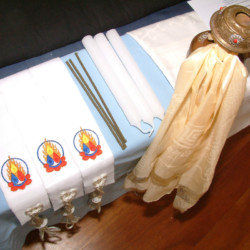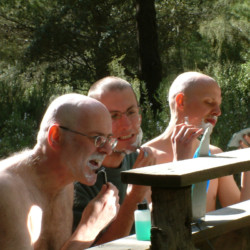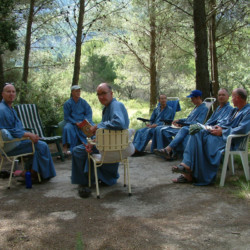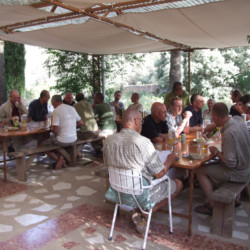
Guhyaloka was purchased in 1986 with money given to Urgyen Sangharakshita for his 60th birthday. He had been hoping to find a property at which to run the annual Ordination Courses during which he ordained men into the Western Buddhist Order (now Triratna Buddhist Order). According to his vision the place needed to be outside the UK so that those being ordained (who were mostly British at that time) would have to travel away from home; it needed to be isolated; and able to provide very simple accommodations. Subhuti and a local friend were looking in the region and, apparently following the flight of an eagle, they came across a perfect property, hidden in the mountains in a steep sided canyon. A community of volunteers moved in and quickly constructed a set of simple huts made mostly from scavenged materials and a stone shrine room and kitchen. This crude, very basic start was gradually improved over the years, as new stone buildings were erected and the kitchen facilities improved. All this was done on a very tight budget. The Ordination Courses were started the following year and ran every year – sometimes twice a year – except 2020 when the Covid-19 epidemic forced the temporary closure of Guhyaloka.
As well as a venue for the Ordination Courses, Guhyaloka has been developed and supported by a small resident community – normally between four and seven men. They live in a separate part of the valley centered on ‘Bhante’s Bungalow’ which was originally intended as a winter residence for Sangharakshita. At the bottom of the property there is a small house which has at various times been used to house the community, as an office, and as space for visitors; nearby there is a workshop.
The third component of Sangharakshita’s vision for Guhyaloka was to establish a Buddhist vihara – a community with no particular teaching or administrative responsibilities – who would simply live together and deepen their Buddhist practice away from all the distractions of normal life. Apparently Sangharakshita once said that the one thing they should do was to stay in the valley – whether they meditated or studied, worked on the land, or engaged in writing or other artistic pursuits was second to this – and that they should live as a community.
Over the decades there have been several attempts to establish a stable vihara and some of the attempts have been successful even if short-lived. The present incarnation of the idea is for the community at Guhyaloka to live more as a ‘forest’ community and to establish a ‘forest’ hermitage and retreat at nearby Uttaraloka.




